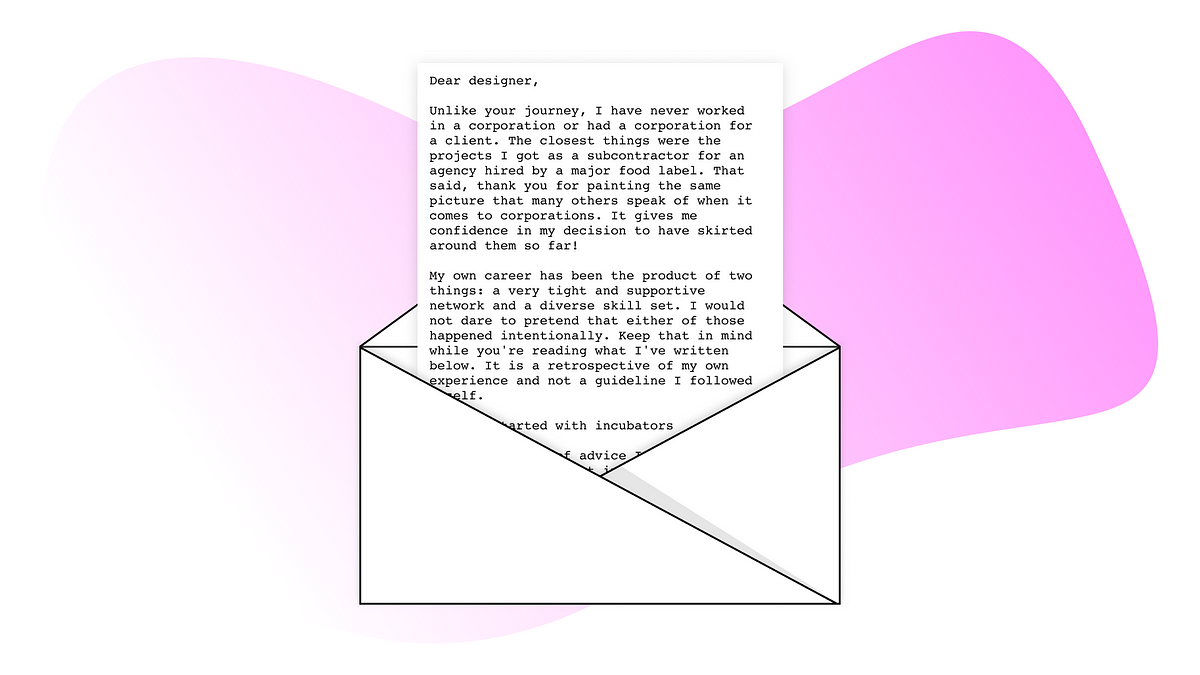Recently a UX designer emailed me asking for my thoughts on moving out of the corporate world and becoming a design consultant in the startup world. Below is a lightly modified version of a 1,000-word email I responded with. If you are a designer in Montreal or elsewhere looking to work with startups, I hope you find this useful.

Unlike your journey, I have never worked in a corporation or had a corporation for a client. The closest things were the projects I got as a subcontractor for an agency hired by a major food label. That said, thank you for painting the same picture that many others speak of when it comes to corporations. It gives me confidence in my decision to have skirted around them so far!
My own career has been the product of two things: a very tight and supportive network and a diverse skill set. I would not dare to pretend that either of those happened intentionally. Keep that in mind while you’re reading what I’ve written below. It is a retrospective of my own experience and not a guideline I followed myself.
Getting started with incubators
The first piece of advice I’d give to anyone looking to get into the startup world is to start with the incubators. It’s not that they’re the best places to find startups. In fact, sometimes the coolest startups aren’t in incubators. However, the incubators will help you understand the culture and language of startups. You can offer them UX workshops for their startups. This was one way that I continuously discovered new clients and stayed top of mind in the community.
Montreal is full of startup communities:
- District 3 Innovation Centre
- Fintech Cadence
- McGill X-1
- Centech
- Zu MTL
- FounderFuel
- BonjourStartup Montreal
- MTL NewTech
- Notman House
- And that’s not even all of them…
Attend events and hackathons
The startup world is big on events, and we have big ones in Montreal such as the Cooperathon by Desjardins. You can participate as a designer if you want to work with other entrepreneurs as a colleague. Alternatively, you can provide your professional services as a mentor. This will expose you to a variety of ideas, potentially land some clients — and hell, maybe a friend or two. Two of the bigger ones in Montreal today are ConUHacks and McHacks.
Much like incubators, these aren’t necessarily where the best startups will emerge. They are great to get a foot in the door and practice working in the chaotic startup environment.
Broaden your skills
In my case, this is where luck, passion, boredom — whatever you want to call it — steps in. While I studied marketing, on the side I used to film YouTube videos for fun, learned UI/UX on my own, and picked up lightweight font-end coding — all by the time I was 20 years old. For a startup, they could get a lot of value out of hiring one person that knows all this. It also made integration between product design and marketing easier, which is key on a small team. Of course, startups don’t pay as well so you’ll be making a bit less money while generating a ton of value — but it’s a ton of fun if you can afford it. The upside is if you choose your clients wisely, you might land yourself into a “rocket ship” or “unicorn” as the startup bros like to call them.
Manage your expectations
Startups and the startup community have their own flavours of corporate toxicity. The big egos, backstabbing, exclusionary cultures, cheap clients, etc. all exist in the startup world as well. They’re just different and are thus handled in different ways. Some things I learned in no order of importance:
- Startups are flaky. Negotiations to get a contract might suddenly end or the startup priorities will completely change at the drop of a hat.
- Startups are cheap as f*ck. With a corporation you might be negotiating contracts in increments of $5000 or $10,000. With startups, expect to find yourself arguing over $50 or $100.
- Startups are disorganized. The smaller teams mean the chain of command is super short and decisions often made on the spot. This is refreshing but it also means there is a lack of proper documentation which leads to lots of confusion. Project goals, deadlines and contractual agreements will be forgotten. Invoices might be lost. Don’t expect much rigor when starting and you’ll relieve yourself from disappointment. Instead, you might have to be the most organized one in the room.
- Startup CEOs are very engaged — for better or worse. It doesn’t matter if the CEO is an engineer, doctor, scientist, philosopher, designer, filmmaker, they will think that they should involve themselves in every decision. At first this used to bother me, but keep in mind that being a CEO is incredibly hard. The constant stress, big ambitions, and parental-like attachment to their ideas seem to scramble their brains a tiny bit.
Start very small… and casual
I must acknowledge that this is more of my own experience and preference. You’ll have to experiment with what works for you. In my experience, startups are often scared of dumping money on a charlatan that’s over-promising deliverables. I treat startup clients like I date: quick and casual at first, and grow slowly. Don’t bother with 6-month agreements and massive deliverables right off the bat. For example, offer to redesign a single screen for a nominal fee and show them that you are agile just like them.
Kill the big reveal
Startup employees don’t want a flashy PowerPoint deck they can use to get into the good graces of of their managers. They want to be involved and have an impact. Make sure to check in frequently with them rather than prepare a giant presentation with a perfect final design. I changed my entire tooling to make this a reality. I design exclusively in Figma, and immediately give the clients view and comment access so they can see the file as it grows. I use Notion to make a wiki for them so that all the links they need are there. I create Google Docs and Sheets for any files so we can comment and collaborate in real time. Finally, I record videos explaining my work on Loom rather than write documents I know they will never read.
Be ballsy and proactive
I recently got a client after I downloaded their app, found some design flaws, and redesigned a section of it myself. I recorded a Loom video of the work I did and emailed it to their customer support team with a link to the Figma file (a
bout 10 hours of work all-in-all). Turns out they were a tiny team of less than 20 people and had no designers. They loved my work, appreciated that I gave away the Figma file and decided to hire me.
If you feel that some of this is inefficient or risky, then you are correct. As I said earlier, working with startups is not necessarily a lucrative affair. You need to be clear about why you’re doing it and what you’d like to achieve. For me, as I am still early in my career, I am searching for projects I consider impactful and challenging. At some point down the line it would be great to settle and dedicate my full energy to one of them. In a twisted way, it’s my own approach to entrepreneurship without necessarily bearing the massive risk of being founder and CEO yet.
Cheers,
Charlie
I hope this was helpful and I’m happy to answer any more questions if need be. You can always add me on LinkedIn or Tweet at me @charlesgedeon.

